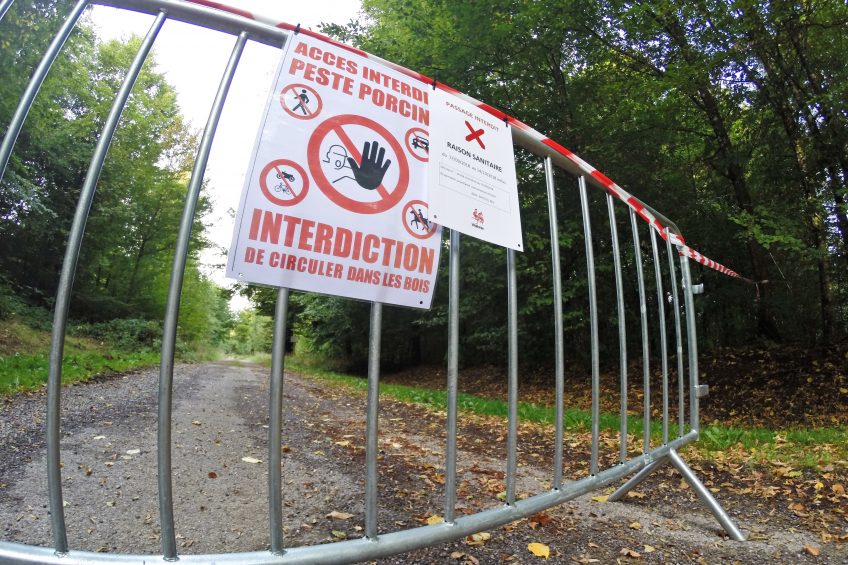ASF Belgium: Army blamed, plea for more fencing, 26 cases

Belgian media have identified a 3rd possible route as to how African Swine Fever might have entered the country: through a military camp site. In the meantime, the European Commission is an advocate of the ‘Czech method’ to combat ASF.
The Belgian news channel RTBF reported on Monday that the military base ‘Lagland’ could be a potential source of the infection. On this 2,600 ha base, about 80 military personnel are working. According to the news channel, the military might have been ‘importing’ the virus.
The Belgian Ministry of Defence confirmed that 2 infected wild boars were found on its base (coloured green in the interactive map below). Until now it remains unclear how exactly the carcasses had arrived there. The institutions involved have indicated that the military premises have now been completely disinfected and no military exercises have been taking place there.
Decomposing wild boar carcass
As can be seen on the interactive map, one of the carcasses was found on September 21. Allegedly, at that moment, the animal had already been decomposing for some while, meaning that it possibly died 2 to 4 weeks prior to that moment. This could mean that this wild boar could well be so-called ‘patient zero’ – the 1st wild boar in Belgium to have contracted the virus.
The matter will likely lead to questions in the Belgian parliament – i.e. as to whether the soldiers are well aware of the importance of biosecurity.

Read everything about African Swine Fever in our special section on the website
3 routes suggested for ASF into Belgium
Apart from the route through the military, there are 2 other theories as to how the virus might have entered Belgium. The 1st theory is that wild boar contracted the virus through consumption of contaminated food, brought in from somewhere. A 2nd theory is that hunters brought live wild boar from Eastern Europe and released them in the forests for hunting purposes.
The Belgian Federal Agency for the Safety of the Food Chain (FASFC), however, has already dismissed the ‘military’ route. In Belgian daily De Standaard, FASFC spokesman Philippe Houdart stated that the Belgian Ministry of Defence is applying very strict disinfection procedures. In his view, the 1st theory would be the most likely.
Czech method to control ASF in wild boar
In the meantime, in Brussels, the European Commission has indicated to be in favour of the so-called ‘Czech method’ to deal with ASF infections in wild boar. In this method, all dead wild boar will be taken out of the nature under controlled conditions, as that is how to remove the source of infections. In addition, in this approach, fencing will be placed around the infected zone, to make sure that no humans enter the area and no pigs will leave the area.
Dutch agricultural newspaper Boerderij reported about Bernard Van Goethem speaking in the European Parliament about the current ASF situation. Mr Van Goethem is part of the department of crisis management of the European Commission’s Directorate-General for Health and Food Safety.
No new cases in the last 6 months
Mr Van Goethem pointed to the fact that in the Czech Republic, no new cases have been reported in the last 6 months, which could point to it being a successful strategy. He expected that soon, the Czech Republic will be declared free from ASF again. The country suffered from outbreaks around the town of Zlín in the south of the country. Outbreaks were only reported from this area.

Read more about African Swine Fever in the Health Tool
Mr Van Goethem also expected that ASF is not a virus that is easily overcome and reminded that there is no vaccine yet. He said, “We cannot shoot all the wild boar. We will have to live with African Swine Fever being among us for the next 20, 30 years.”
Infected wild boar count: 52
The total number of infected wild boar in Belgium, reported to the World Organization for Animal Health (OIE) is 52, found in 26 different cases. Mostly these were infected carcasses, incidentally a sick animal was shot. The updated map (see above) shows where exactly.
Within the orange zone (the infected zone of 63,000 ha), no movement of pigs is allowed, and swine on existing farms were culled. In total, this concerned about 4,000 animals.











